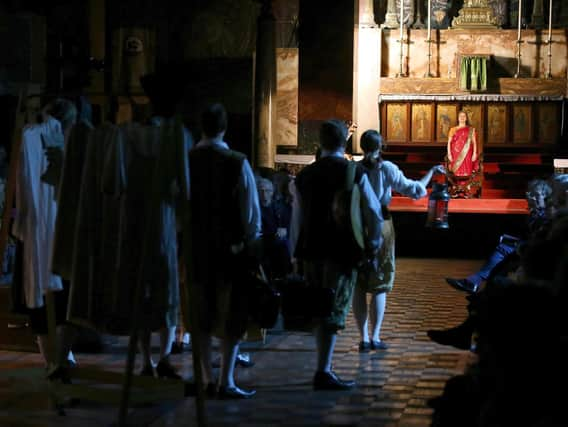REVIEW: Brighton Early Music Festival 2017


James Hall, countertenor; Debipriya Sircar, Indian classical vocalist. Sanjay Guha, sitar; Jamie Akers, lute & baroque guitar; Emily Baines, recorder & shawm; Lucia Caparello, viola da gamba; George Clifford, violin; Katie de la Matter, harpsichord & creative direction. Francesca Bridge-Cicic, stage direction; Lori Hopkins, puppets; Austeja Znaidauskaite, design; Dominique Munday, assistant stage direction, DSM.
Think the late 1960s preponderance in pop music of sitar, post-The Beatles in India. And their unusual songs ‘Norwegian Wood’ and ‘Within You, Without You’; and the mood-catching spin-offs like Moody Blues’album track ‘Om’ and Traffic’s hit ‘Hole In My Shoe’. Guitarists George Harrison, Justin Hayward and Dave Mason took up the instrument and they all sold millions. (How time flies)
Advertisement
Hide AdAdvertisement
Hide AdThere were no female Indian singers in sight during that British male outbreak of mesmeric eastern musical fever on home soil. Ensemble Tempus Fugit now put that right, some 50 years later for the audience at St Bart’s. They were flashing us back to the 18th Century, when Sophia Plowden went to action 200 years before the phrase pop-fusion was coined. And when Harrison, as a man, might have made more fans by singing an octave higher.
The sound of the sitar, from on high in the chancel steps, hazed across the long vast St Bart’s airspace, underlayering and overlayering a sonic sandwich of fellow early music instruments. And the smooth cream on top were the voices of countertenor James Hall or Debipriya Sircar, solo or together.
In Calcutta the British colonials, with their own folk and traditional music and instruments, were imbibing Indian music, and marinating, then cooking it their own.
We in St Bart’s learned from Katie De la Matter’s programme notes that East India Company Merchant housewife Plowden and her friend Margaret Fowke enjoyed the inevitable cross-cultural mixing of British musicians with Indian in Calcutta street life. (Musicians don’t have a colour or language problem). Then Plowden and Fowke went to Lucknow (where Cliff Richard was later born) and invited local musicians into their drawing rooms for jam sessions.
Advertisement
Hide AdAdvertisement
Hide AdThus, imported European harpsichords and stringed instruments became new curry with sitars and percussion instruments. Likewise, voices started being spice-blended. Romanzas met ragas, Welsh traditional met tabla and tambura, viola da gamba met dilruba, fiddle met fiddle and all became well between the not-so separate worlds. Inspired by these explorative soirees, Fowke and John Braganza started writing down music adapting Indian styles to British, and notating the Indian in western manuscript. Later music publication drew on some of this work.
De la Matter writes: “This should not have worked. European and Indian music are totally different musical languages.” But her Ensemble Tempus Fugit show demonstrates that what 60s pop did effortlessly they could do now in this “Calcutta” project. What’s difficult? Indian music is rhythm and melody, western is the same plus harmony. Sitar and bagpipe are equating drone instruments: melody over a pedal point. Melodically and lyrics-wise, the two worlds differ but are compatible. Off the written page, little complexity exists. Just listen to your ears.
“Calcutta” celebrates this and amplifying the inherently weak-volumed sitar was the only pre-requisite to success.
But De la Matter’s “Calcutta” show is more than bi-cultural music hybridised. A simple enacted and costumed story of a young man having to leave his Britain on Indian colonial assignment is acted and decorated. He departs sorrowfully to Dowland, crosses the storm-tossed exotically-inhabited seas to Locke’s Tempest music and Purcell’s ‘O lead me to some peaceful gloom’.
Advertisement
Hide AdAdvertisement
Hide AdOn arrival and welcome into the new world, two traditional Indian songs bookend another by Purcell and suddenly, interspersed with more ravishingly unending Indian melodies, comes ‘Ap Shenkin’, a striking folk tune, bearing the words of ‘The girl I left behind me’ adds Welsh sunshine to the sub-continent heat.
Story illustration comes from lighting, and supporting actresses with stick puppets of animals and boats, sensational jellyfish, and from silhouettes and projections behind gauze at one end of an auditorium – in which audience is laid out lengthways on three sides of the musicians and acting area. Costumes are 17th Century blouses, breeches and waistcoats.
Musical touches I particularly enjoyed were the advancing one-tone steps up in pitch between certain items. The first was when the British musicians arrived noisily and, perhaps dismissing the sound of the resident sitar, began tuning up in C. It depicted assumed superiority. Later, the score was evened up, in exactly the same way when Purcell finished and Sircar began singing her first Indian song in a new tonality.
“Calcutta” was sold out a fortnight in advance, to 300 people who have seen Guy Fawkes Night fireworks all before, and preferred the possibility of experiencing something alternatively memorable like this. The lure of BREMF, and its reward of the unexpected and the inventive, grows year on year (how time flies).
“Calcutta” deserves the 2018 tour it desires. Let it go into all corners, and speak for diversity.
Richard Amey
www.tempusfugit.co.uk
www.bremf.org.uk